Hanga Roa is a special place on Easter Island’s southwest coast. It mixes old Polynesian culture with new ideas. This town welcomes people from everywhere to see its history and famous moai statues.
Hanga Roa is home to about 7,750 people. It’s more than just a starting point for tourists. It shows how strong Polynesian culture is. The town is full of life, with markets, smells of food, and Rapa Nui music.
Being close to the moai statues, Hanga Roa is perfect for those who love adventure. The town is full of cultural experiences. You can enjoy the Tapati Rapa Nui festival or talk to locals who love to share their stories.
Key Takeaways
- Hanga Roa is the capital and main urban center of Easter Island
- The town has a population of about 7,750
- It serves as the primary base for exploring Easter Island’s archaeological sites
- Hanga Roa offers a unique blend of ancient Polynesian heritage and modern influences
- The annual Tapati Rapa Nui festival showcases the island’s rich cultural traditions
- The town is known for its proximity to the famous moai statues
Introduction to Easter Island’s Cultural Heart
Hanga Roa is the lively capital of Easter Island. It’s a doorway to ancient secrets and stunning views. This small town, with about 8,000 people, is the heart of Rapa Nui culture. It’s where your journey to the island’s wonders begins.
Location and Geographic Significance
Easter Island is at the Polynesian Triangle’s eastern tip, in the vast Pacific Ocean. It’s 3,500 km from Chile, making it the world’s most isolated inhabited island. This isolation has greatly influenced its culture and environment.
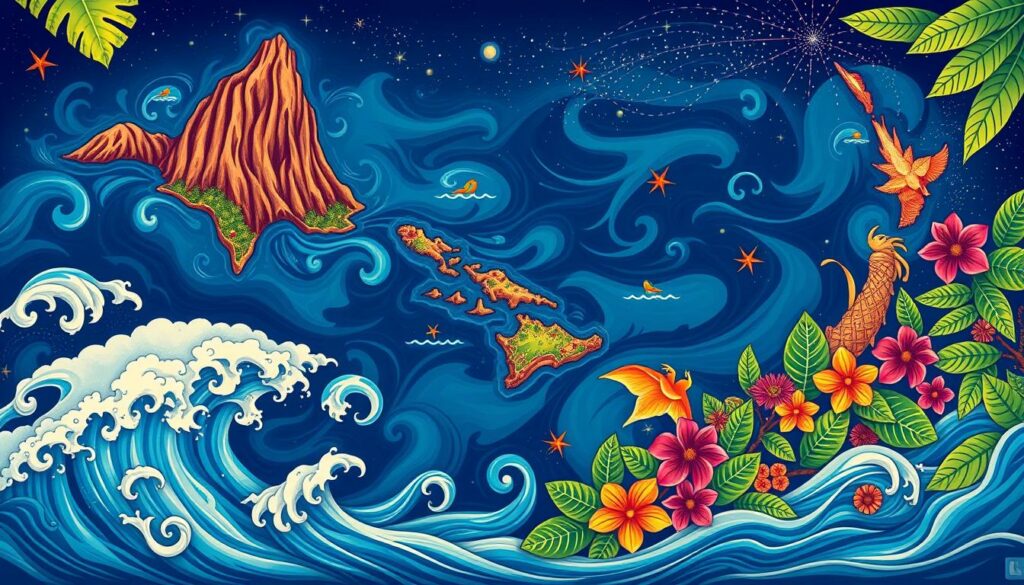
Brief Historical Overview
The history of Easter Island is as fascinating as its moai statues. Polynesians arrived around 1200 AD, building a society that crafted the giant statues. European discovery in 1722 brought big changes to the island’s people.
Modern Cultural Significance
Today, Hanga Roa proudly preserves Rapa Nui’s heritage. It leads to Rapa Nui National Park, a UNESCO World Heritage site. The park is home to many archaeological wonders, including the famous moai statues, some over 30 feet tall. The Tapati Rapa Nui Festival in February celebrates traditional music, dance, and competitions. It shows the strong spirit of Easter Island’s culture.
| Feature | Description |
|---|---|
| Population | ~8,000 |
| Distance from Chile | 3,500 km |
| Moai Construction Period | 1250 AD – 1500 AD |
| Annual Cultural Event | Tapati Rapa Nui Festival |
Getting to Hanga Roa
Getting to Hanga Roa on Easter Island is an adventure. The journey starts at Mataveri International Airport, close to the town center. This airport, with its wide runway, is the entrance to this Polynesian paradise.
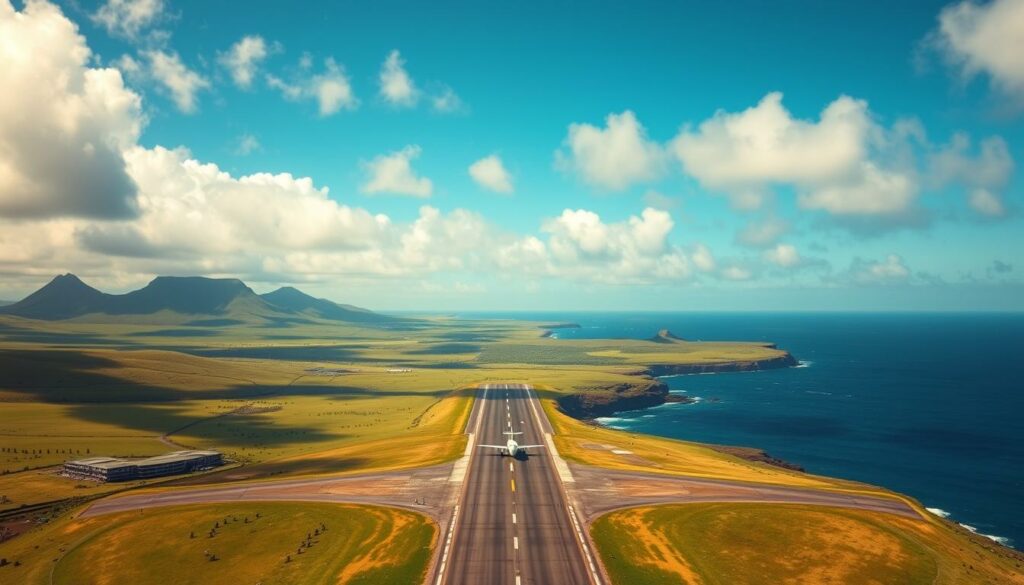
LATAM Airlines connects Easter Island to the world. The main route is from Santiago, Chile, with flights about 12 times a week. The flight from Santiago to Easter Island takes around 5.5 hours, crossing the Pacific Ocean.
Arriving at Easter Island is unique. After landing, you must buy a ticket to Rapa Nui National Park. This ticket, costing about $80 for 10 days, lets you see the island’s cultural wonders, like the moai statues.
- Flight duration: About 5.5 hours from Santiago
- Ticket cost: Approximately $80 for 10-day park access
- Best travel period: December to March (summer season)
Travelers on a budget should know that flight prices change a lot. June might be cheaper, but November is pricier. Traveling in the shoulder seasons can save you money on your Easter Island trip.
The History and Legacy of Hanga Roa
Hanga Roa, the largest village on Easter Island, has a rich history. It started with Polynesian voyagers arriving around 300-400 CE. They brought the seeds of Rapa Nui culture, which grew and changed over time.
Polynesian Settlement Period
The Polynesian settlers built a complex society on Easter Island. They grew crops like bananas and taro, fitting into the island’s unique environment. By 1722, when Europeans first arrived, the population was around 2,000 to 3,000.
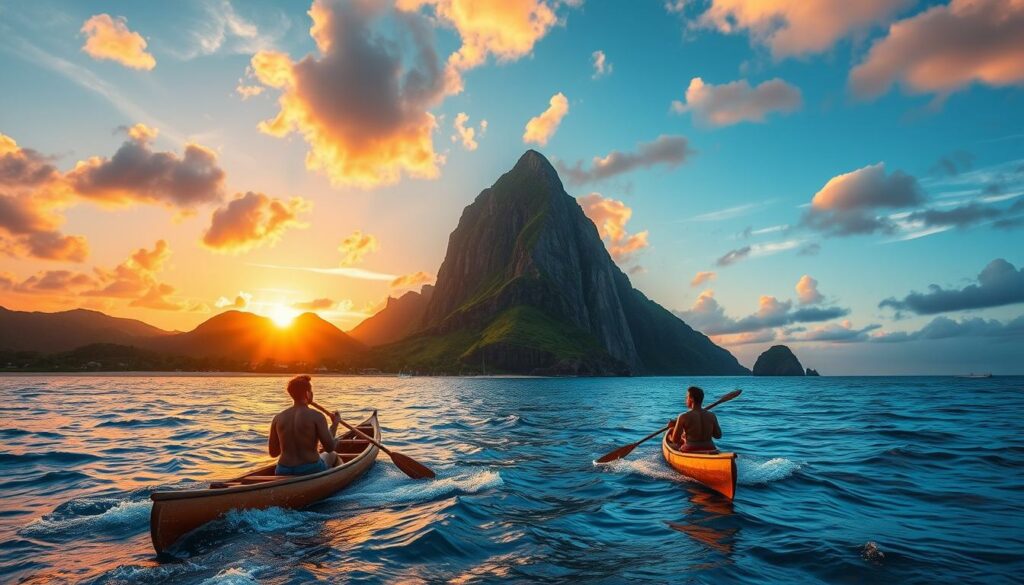
European Discovery and Chilean Annexation
Dutch navigator Jacob Roggeveen found Easter Island in 1722. He was amazed by the moai statues. Later, James Cook visited in 1774, noting the island’s dwindling population. Chile took control of Easter Island in 1888.
Modern Development and Tourism
Today, Hanga Roa mixes old traditions with new ways. It’s home to about 3,300 people and is the island’s main hub. Tourism boosts the local economy, attracting visitors to the island’s ancient sites and natural wonders.
| Year | Event | Population |
|---|---|---|
| 300-400 CE | Estimated initial settlement | Unknown |
| 1722 | First European contact | 2,000-3,000 |
| 1877 | Population decline | 111 |
| 1965 | Full Chilean citizenship granted | Unknown |
| Present | Hanga Roa’s current population | ~3,300 |
Culture and Local Life in Hanga Roa
Hanga Roa is alive with Easter Island’s vibrant culture. The town has 5,000 people, a mix of native Rapa Nui and newcomers. They keep Polynesian traditions alive. The Rapa Nui language and Spanish mix in the streets, creating a unique sound.
Life in Hanga Roa is a mix of old customs and new tourism. Markets are full of life, with traditional crafts and fresh food. Visitors might see dance performances or hear stories from elders.
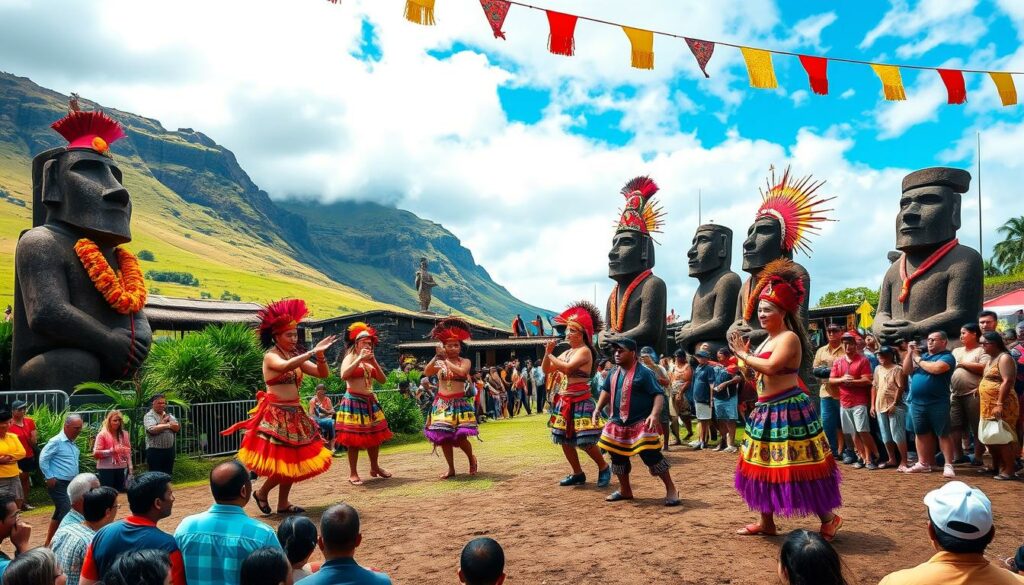
The Tapati Festival in February is a big event. It lasts two weeks and shows off Rapa Nui music, dance, and sports. Locals compete in events like spear throwing and outrigger canoe races. Tourists come to see this amazing display of Polynesian culture.
“Our festival is a time to honor our ancestors and share our culture with the world,” says Maria, a local artisan.
Even with over 100,000 tourists each year, Hanga Roa keeps its culture strong. Many people use both Spanish and Rapa Nui names, showing their heritage. This mix of old and new makes island life rich and inviting for visitors.
Archaeological Treasures and Moai Sites
Hanga Roa is the entrance to Easter Island’s vast archaeological world. The island is home to almost 900 moai statues. These giants, some reaching 30 feet tall and weighing 80 tons, show the ancient Rapa Nui people’s genius.
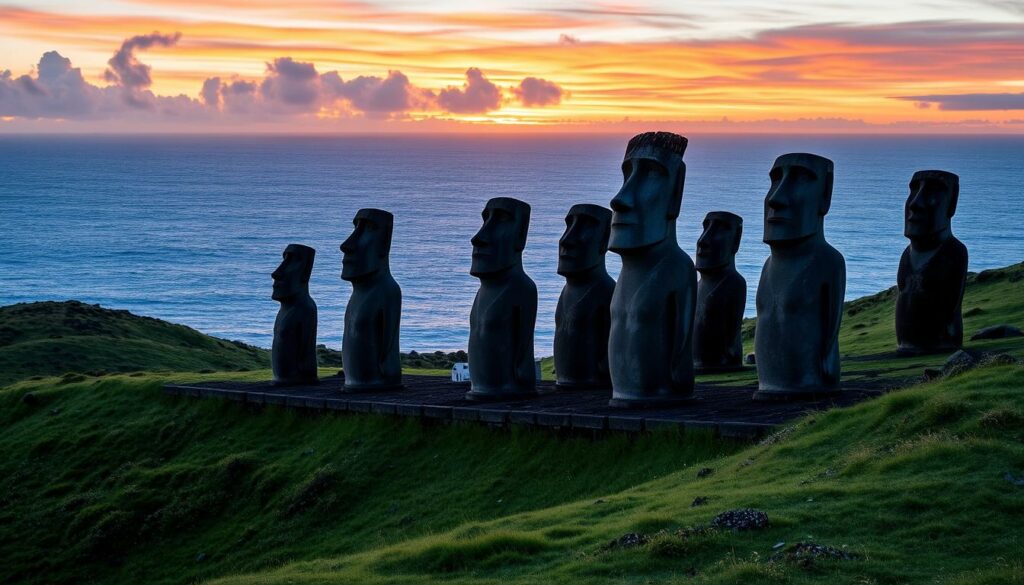
Tahai Ceremonial Complex
Close to Hanga Roa is the Tahai Ceremonial Complex. It’s a key part of Rapa Nui’s history. Here, three ahu platforms hold moai statues, giving a peek into the island’s past.
Ahu Ko Te Riko
Ahu Ko Te Riko is special among Easter Island’s 300 ahu platforms. It has a moai with coral eyes, showing spiritual power. This statue is one of three with a pukao, or red hat, making it very important.
Sacred Ceremonial Grounds
Around Hanga Roa, you’ll find sacred grounds and smaller moai. These sites reveal much about Easter Island’s past and the Rapa Nui civilization.
Easter Island’s treasures, like the moai and ahu platforms, fascinate everyone. The island’s history, kept in stone, invites us to explore and marvel. It’s a unique place for those who love ancient cultures and mysteries.
Natural Wonders and Landscapes
Easter Island’s ecology shows its volcanic roots and isolated spot. The island is covered with volcanic craters. Each crater gives a peek into the island’s past and its current ecosystem.
Volcanic Formations
Three extinct volcanoes form the island’s shape, with Mount Terevaka at 1,969 feet. The craters of Rano Kao, Rano Raraku, and Rano Aroi are home to different ecosystems. Rano Kau, a huge volcano and crater lake, is a key natural wonder that shows the island’s volcanic past.
Coastal Features
The coast near Hanga Roa has eroded cliffs and rough lava formations. Anakena Beach, in Rapa Nui National Park, is the island’s most famous beach. In warmer months, you might see Rapa Nui sea turtles eating algae in Hanga Roa and Hanga Piko bays.
Indigenous Flora and Fauna
Easter Island’s plants and animals are rare but special. The toromiro tree, brought back, is a key native plant. The island’s wildlife mainly includes seabirds and sea creatures. Efforts are being made to protect and restore the island’s natural beauty.
| Natural Feature | Description | Ecological Significance |
|---|---|---|
| Rano Kau | Volcanic crater lake | Unique microclimate, supports diverse plant life |
| Anakena Beach | White sand beach | Nesting site for sea turtles |
| Toromiro Tree | Endemic plant species | Symbol of island’s conservation efforts |
Practical Travel Information
Planning your trip to Easter Island needs some thought. The island’s remote spot affects many parts of your journey. This includes finding places to stay and how to get around.
Hanga Roa, where 95% of people live, has many lodging options. You can choose from luxury resorts to cozy guesthouses. The Hangaroa Eco Village & Spa is a favorite for those who care about the environment.
Traveling around the island can be a bit of a challenge. There’s no public bus system. So, most people rent cars or join guided tours. Local people usually offer car rentals since big companies don’t have a presence here. Remember, car insurance isn’t available, so be extra careful while driving.
If you prefer guided tours, booking with local guides is a smart choice. It helps the local economy and makes sure you see all the best spots.
| Travel Aspect | Details |
|---|---|
| Currency | Chilean Peso (CLP) |
| Time Zone | GMT-6 |
| Local Transportation | Car rentals, guided tours |
| Language | Spanish, English common in tourism |
Be ready for higher prices because of the island’s isolation. The Chilean Peso is the official money. While big places take credit cards, it’s smart to have cash for small shops.
Also, a guide is now needed to visit most national park areas. This rule is to protect the culture and support local jobs. It means you can’t explore on your own, but it makes the experience richer.
Local Cuisine and Dining Experiences
Easter Island’s food scene is a mix of Polynesian and Chilean flavors. Hanga Roa’s restaurants use traditional cooking and fresh local ingredients. This makes dining a memorable experience for the 100,000 visitors each year.
Traditional Rapa Nui Dishes
Seafood is a big part of the island’s food, with mahi-mahi, tuna, and octopus being favorites. You must try the Easter Island curanto, a feast cooked in an underground oven. It’s a mix of meats, veggies, and seafood, showing the heart of Rapa Nui’s cooking.
Local Markets and Food Culture
Hanga Roa’s markets are lively, filled with fresh produce and seafood. You can try local treats like sweet potato gnocchi or fresh fruit tarts. For a quick bite, try empanadas with tuna or shrimp, showing the island’s food culture.
Fresh Seafood Specialties
Hanga Roa’s restaurants are known for their seafood. At Kona o’ Pule, enjoy Polynesian ceviche for 19,000 pesos ($20). Taha Tai Restaurant offers slow-cooked baby back ribs for 18,500 pesos ($20). For a unique experience, visit Te Moai Sunset, with stunning ocean views and dishes like shrimp and octopus risotto.
| Restaurant | Specialty Dish | Price (CLP) |
|---|---|---|
| Kona o’ Pule | Polynesian Ceviche | 19,000 |
| Taha Tai | Baby Back Ribs | 18,500 |
| La Boulangerie | Cappuccino | 6,500 |
Hanga Roa has something for everyone, from casual spots to fancy restaurants. It’s a great way to explore Easter Island’s food treasures.
Conclusion
Hanga Roa is the heart of Easter Island travel, blending ancient mystery with modern charm. This small town, home to 2,500 people, is the perfect spot for an unforgettable Rapa Nui experience. It welcomes visitors to explore the wonders of this remote Pacific island.
The island is famous for its iconic moai statues and vibrant local culture. The UNESCO World Heritage Site, Rapa Nui National Park, showcases the island’s treasures and natural beauty. Visitors can dive into the island’s history, from its Polynesian settlement to its European discovery.
Despite its small size of 163.6 km², Easter Island is packed with cultural significance and stunning landscapes. The island’s unique mix of Polynesian and Chilean influences creates a fascinating cultural tapestry. With a population of around 8,000, half of whom are of Rapa Nui descent, visitors can have authentic interactions with locals and experience their traditions firsthand.
When planning your Easter Island travel, remember it operates on its own pace. Enjoy the laid-back atmosphere, try the local cuisine, and get ready for an adventure that will leave you with unforgettable memories of this extraordinary place.
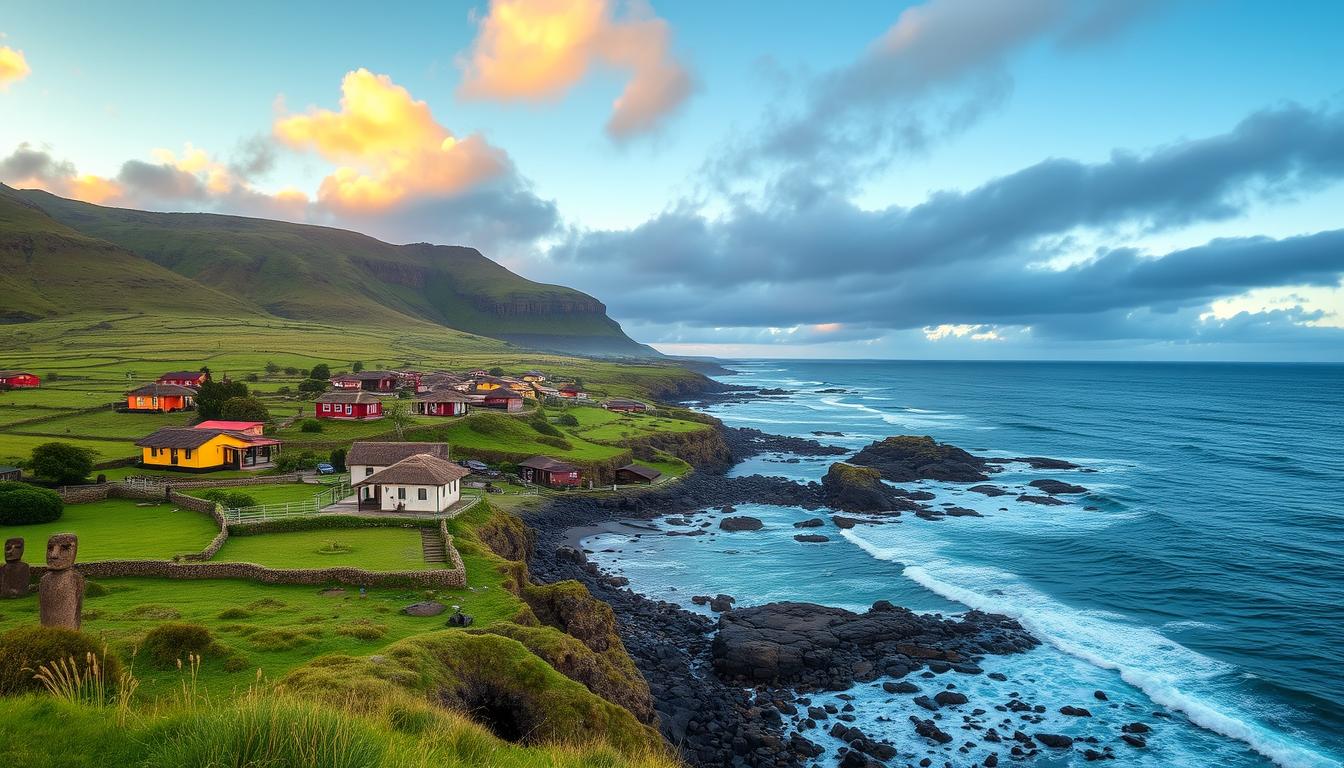
No responses yet